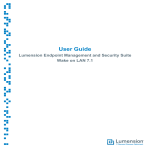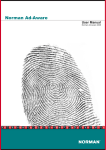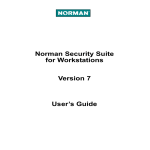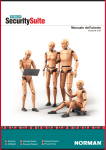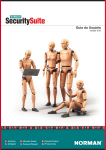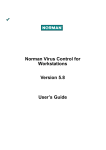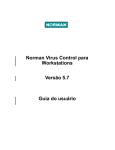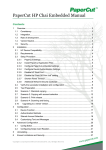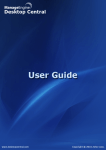Download Norman Enterprise Security: Wake on LAN 8.0 User Guide
Transcript
User Guide Norman Enterprise Security Wake on LAN 8.0 Norman Enterprise Security: Wake on LAN -2- Notices Version Information Norman Enterprise Security: Wake on LAN User Guide - Norman Enterprise Security: Wake on LAN Version 8.0 Published: May 2014 Document Number: 02_207M_8.0_141211409 Copyright Information Lumension Security, Inc. 8660 East Hartford Drive, Suite 300 Scottsdale, AZ 85255 Copyright© 1999-2014; Lumension Security, Inc.; all rights reserved. Covered by one or more of U.S. Patent Nos. 6,990,660, 7,278,158, 7,487,495, 7,823,147, 7,870,606, and/or 7,894,514; other patents pending. This manual, as well as the software described in it, is furnished under license. No part of this manual may be reproduced, stored in a retrieval system, or transmitted in any form – electronic, mechanical, recording, or otherwise – except as permitted by such license. LIMITATION OF LIABILITY/DISCLAIMER OF WARRANTY: LUMENSION SECURITY, INC. (LUMENSION) MAKES NO REPRESENTATIONS OR WARRANTIES WITH REGARD TO THE ACCURACY OR COMPLETENESS OF THE INFORMATION PROVIDED IN THIS MANUAL. LUMENSION RESERVES THE RIGHT TO MAKE CHANGES TO THE INFORMATION DESCRIBED IN THIS MANUAL AT ANY TIME WITHOUT NOTICE AND WITHOUT OBLIGATION TO NOTIFY ANY PERSON OF SUCH CHANGES. THE INFORMATION PROVIDED IN THIS MANUAL IS PROVIDED “AS IS” AND WITHOUT WARRANTY OF ANY KIND, INCLUDING WARRANTIES OF MERCHANTABILITY AND FITNESS FOR A PARTICULAR PURPOSE. THE INFORMATION PROVIDED IN THIS MANUAL IS NOT GUARANTEED OR WARRANTED TO PRODUCE ANY PARTICULAR RESULT, AND THE ADVICE AND STRATEGIES CONTAINED MAY NOT BE SUITABLE FOR EVERY ORGANIZATION. NO WARRANTY MAY BE CREATED OR EXTENDED WITH RESPECT TO THIS MANUAL BY SALES REPRESENTATIVES OR WRITTEN SALES MATERIALS. LUMENSION SHALL NOT BE LIABLE TO ANY PERSON WHATSOEVER FOR ANY LOSS OF PROFIT OR DATA OR ANY OTHER DAMAGES ARISING FROM THE USE OF THIS MANUAL, INCLUDING BUT NOT LIMITED TO DIRECT, INDIRECT, SPECIAL, INCIDENTAL, CONSEQUENTIAL, OR OTHER DAMAGES. -3- Norman Enterprise Security: Wake on LAN Trademark Information Lumension®, Lumension® Endpoint Management and Security Suite, Lumension® Endpoint Management Platform, Lumension® Patch and Remediation, Lumension® Enterprise Reporting, Lumension® Security Configuration Management, Lumension® Content Wizard, Lumension® Risk Manager, Lumension® AntiVirus, Lumension® Wake on LAN, Lumension® Power Management, Lumension® Remote Management, Lumension® Scan™, Lumension® Security Configuration Management, Lumension® Application Control, Lumension® Device Control, Lumension® Endpoint Security, Lumension® Intelligent Whitelisting, PatchLink®, PatchLink® Update™, their associated logos, and all other Lumension trademarks and trade names used here are the property of Lumension Security, Inc. or its affiliates in the U.S. and other countries. Norman®, Norman SandBox®, Norman Virus Control®, the Norman product and service names, their associated logos, and all other Norman trademarks and trade names used here are the property of Norman ASA in the U.S., the European Union, and other countries. RSA Secured® is a registered trademark of RSA Security Inc. Apache is a trademark of the Apache Software Foundation. In addition, any other companies' names, trade names, trademarks, and products mentioned in this document may be either registered trademarks or trademarks of their respective owners. -4- Table of Contents Table of Contents Preface: About This Document.................................................................................................................................. 7 Typographical Conventions..........................................................................................................................................................7 Contacting Norman...................................................................................................................................................................... 8 Chapter 1: Wake on LAN Overview....................................................................................................................... 11 About Wake on LAN................................................................................................................................................................. 11 About Wake Requests................................................................................................................................................................ 12 Major Features of Wake on LAN..............................................................................................................................................12 Advantages of Using Wake on LAN.........................................................................................................................................13 The Wake on LAN Process....................................................................................................................................................... 13 Chapter 2: Installing Wake on LAN....................................................................................................................... 15 Explaining Module Subcomponents.......................................................................................................................................... 15 Minimum Hardware Requirements......................................................................................................................................16 Supported Wakepoint Client Environments........................................................................................................................ 16 Logging In.................................................................................................................................................................................. 16 Installing the Wake on LAN Module Server Component.........................................................................................................17 Uninstalling the Wake on LAN Module Server Component.................................................................................................... 19 Defining Wakepoints.................................................................................................................................................................. 19 Post Installation Tasks................................................................................................................................................................22 Updating the Wake on LAN Module........................................................................................................................................ 22 Chapter 3: Using the Web Console......................................................................................................................... 25 Common Functions.................................................................................................................................................................... 25 Common Conventions..........................................................................................................................................................25 The Navigation Menu.......................................................................................................................................................... 26 The Page Banner..................................................................................................................................................................27 List Pages............................................................................................................................................................................. 27 Toolbars................................................................................................................................................................................ 28 The Options Menu............................................................................................................................................................... 28 Filters.................................................................................................................................................................................... 29 Group By..............................................................................................................................................................................33 Expanding and Collapsing Structures..................................................................................................................................34 Advancing Through Pages...................................................................................................................................................34 Help...................................................................................................................................................................................... 35 Exporting Data..................................................................................................................................................................... 35 The Home Page..........................................................................................................................................................................36 The Dashboard..................................................................................................................................................................... 36 Dashboard Setting and Behavior Icons............................................................................................................................... 37 Previewing and Printing the Dashboard..............................................................................................................................38 Editing the Dashboard......................................................................................................................................................... 38 The System Alert Pane........................................................................................................................................................ 39 License Expiration................................................................................................................................................................40 -5- Norman Enterprise Security: Wake on LAN Chapter 4: Managing Wakepoints........................................................................................................................... 41 About Wakepoints...................................................................................................................................................................... 41 Configuring Wakepoints.............................................................................................................................................................41 Working with Wakepoints.......................................................................................................................................................... 42 Adding a Wakepoint............................................................................................................................................................ 42 Removing a Wakepoint........................................................................................................................................................43 Chapter 5: Waking Endpoints..................................................................................................................................45 Wake on LAN Scheduling Methods..........................................................................................................................................46 The Wake on LAN Page............................................................................................................................................................46 The WOL Configuration Tab.....................................................................................................................................................47 Wake Times.......................................................................................................................................................................... 48 Scheduling............................................................................................................................................................................ 48 Wakepoint Configuration..................................................................................................................................................... 49 The Endpoint Wake Times Tab................................................................................................................................................. 50 The Endpoint Wake Times Tab Toolbar............................................................................................................................. 50 The Endpoint Wake Times Tab List....................................................................................................................................51 Working with Wake on LAN.....................................................................................................................................................51 Scheduling Wake Requests by Hours of Operation............................................................................................................ 52 Scheduling Wake Requests by Custom Daily Times.......................................................................................................... 56 Wake Endpoints from the Endpoint Wake Times Tab........................................................................................................ 57 Appendix A: Configuring Windows 8 Endpoints for Wake on LAN...................................................................61 Disabling Fast Startup................................................................................................................................................................ 61 -6- Preface About This Document This User Guide is a resource written for all users of Norman Enterprise Security: Wake on LAN 8.0. This document defines the concepts and procedures for installing, configuring, implementing, and using Norman Enterprise Security: Wake on LAN 8.0. Tip: Norman documentation is updated on a regular basis. To acquire the latest version of this or any other published document, please refer to the Norman User Manuals page at http://www.norman.com/support/ user_manuals/. Typographical Conventions The following conventions are used throughout this documentation to help you identify various information types. Table 1: Typographical Conventions Convention Usage bold Buttons, menu items, window and screen objects. bold italics Wizard names, window names, and page names. italics New terms, options, and variables. MONOSPACE UPPERCASE Keyboard keys. BOLD UPPERCASE SQL Commands. monospace File names, path names, programs, executables, command syntax, and property names. -7- Norman Enterprise Security: Wake on LAN Contacting Norman Headquarters Norman ASA P.O. Box 43 N-1324 Lysaker, Norway Tel: +47 67 10 97 00 Fax: +47 67 58 99 40 E-mail: [email protected] (To be used if you want to contact Norman HQ) Web: www.norman.com Denmark Spain Norman Data Defense Systems A/S Blangstedgårdsvej 1, DK-5220 Odense SØ Tel: +45 7025 3508 Fax: +45 6590 5102 Email: [email protected] Web: www.norman.com/dk Norman Data Defense Systems Camino Cerro de los Gamos 1, Edif.1 28224 Pozuelo de Alarcón MADRID Tel: +34 917 90 11 31 Fax: +34 917 90 11 12 Email: [email protected] Web: www.norman.com/es France Sweden Norman France 8 Rue de Berri, F-75008 Paris Tel: +33142999509 Fax: +33142999501 Email: [email protected] Web: www.norman.com/fr Norman Data Defense Systems AB Norrköping Science Park, S-602 86 Norrköping Tel: +46 11 230 330 Fax: +46 11 230 349 Email: [email protected] Web: www.norman.com/se Germany Switzerland Norman Data Defense Systems GmbH Zentrale, Gladbecker Str. 3, D-40472 Düsseldorf Tel: +49 0211 586 99-0 Fax: +49 0211 586 99-150 Email: [email protected] Web: www.norman.com/de Norman Data Defense Systems AG Münchensteinerstrasse 43, CH-4052 Basel Tel: +41 61 317 25 25 Fax: +41 61 317 25 26 Email: [email protected] Web: www.norman.com/ch -8- Preface Italy United Kingdom Norman Data Defense Systems Milano San Felice, Strada 2, Torre 1 20096 Pioltello (MI) Tel: +39 02 7030 5479 Fax: +39 02 7030 5480 Email:[email protected] Web: www.norman.com/it Norman Data Defense Systems (UK) Ltd CBXII, West Wing, 382-390 Midsummer Boulevard Central Milton Keynes, MK9 2RG Tel: +44 1908 847413 Fax: +44 870 1202901 Email:[email protected] Web: www.norman.com/en-uk Netherlands United States Norman SHARK B.V. Postbus 159, 2130 AD Hoofddorp Tel: +31 23 78 90 222 Fax: +31 23 56 13 165 Email: [email protected] Web: www.norman.com/nl Norman Data Defense Systems Inc. 9302 Lee Highway, Suite 950A, Fairfax, Virginia 22031 Tel: +1 703 267-6109 Fax: +1 703 934-6368 Email: [email protected] Web: www.norman.com/en-us Norway Norman ASA (Headquarter and sales Norway / Hovedkontor og salg Norge) Visit: Strandveien 37, Lysaker Mail: PO Box 43, N-1324 Lysaker Tel: +47 67 10 97 00 Fax: +47 67 58 99 40 Email: [email protected] Web: www.norman.com/no For additional contact information, please visit the Norman offices page at http://www.norman.com/ about_norman/contact/information/offices/. Norman Technical Support For a list of contact information for Norman Support, please visit the Contact support page at http://contactsupport.norman.com/ -9- Norman Enterprise Security: Wake on LAN - 10 - Chapter 1 Wake on LAN Overview In this chapter: • • • • • About Wake on LAN About Wake Requests Major Features of Wake on LAN Advantages of Using Wake on LAN The Wake on LAN Process Wake on LAN is a Norman Enterprise Security module you can use to power on endpoints within your network without physically turning them on. With this capability, daily management tasks are simplified, desktop and laptop energy consumption is reduced, and system management tasks that interfere with employee productivity are prevented. Wake on LAN (WOL) is a module you can install within Norman Enterprise Security. Use this module to control the power status of endpoints within the network (on or off), thereby managing tasks that occur at a specific time each day. Using WOL, you can ensure swift deployment of critical security patches and ensure that every endpoint within the network is powered on during scheduled patch assessment. These functions are especially beneficial to organizations with networks containing thousands of endpoints. Using WOL, you can perform maintenance tasks for multiple endpoints after regular business hours, thus minimizing employee productivity disruption. Note: Although WOL can wake endpoints from an off state, most network cards include security features to prevent remote boots. Therefore, Norman recommends using WOL to wake endpoints in a sleeping or hibernating state. About Wake on LAN Wake on LAN (WOL) is a Norman Enterprise Security module containing features you can use to power on network endpoints. To power on endpoints, Wake on LAN sends specific Wake on LAN network packets, called wake requests, to endpoints hosting the Norman ESEC Agent. Most network interface cards support a listening mode, enabling them to receive network packets even when the endpoints that host them are powered off, hibernating, or sleeping. You can use Wake on LAN to power on endpoints by sending network packets (known as wake requests) to endpoints hosting the Norman ESEC Agent. - 11 - Norman Enterprise Security: Wake on LAN About Wake Requests Wake Requests are network packets that Wake on LAN sends to network endpoints. These packets contain code that wake recipient endpoints from a suspended, hibernating, or powered-off state. Wake requests are sent from the Norman Enterprise Security to wakepoints. Wakepoints then relay the request to managed endpoints. For additional information about wakepoints, refer to About Wakepoints on page 41. Wakepoints use limited broadcast to relay wake requests to agent-managed endpoints within their subnet. During limited broadcast, the wakepoint sends the wake request to the 255.255.255.255 IP address. By sending the wake request to this address, a wake request is sent to all endpoints within the subnet. When managed agents receive the wake request, their host endpoints are woken. Wake requests send packets called magic packets. Magic packets include the broadcast address (255.255.255.255) and endpoint MAC addresses, which are discovered using the Norman ESEC Agent. When managed endpoints receive this request, they are powered on after recognizing the broadcast address and their unique MAC address. Major Features of Wake on LAN Wake on LAN (WOL) features are beneficial to organizations of all sizes. You can use WOL to power on endpoints for maintenance purposes. With WOL, you can maintain large networks containing thousands of endpoints or smaller networks where an administrator only manages a handful of endpoints. WOL includes the following features: • • • Wake Windows endpoints, regardless of operating system version. Schedule wake requests to power on endpoints. Immediately send wake requests using the Wake Now feature. - 12 - Wake on LAN Overview Advantages of Using Wake on LAN Wake on LAN contains features that benefit administrators of networks of all sizes. With Wake on LAN, you can power on endpoints at your convenience, and then complete various administration tasks. The following list itemizes the benefits of using Wake on LAN features: • • • • • • Enables administrators to complete administrative tasks following business hours using other Norman Enterprise Security modules. Because endpoint maintenance can be performed following business hours, employees can operate their endpoints without interruption during business hours. Because endpoints can be woken, employees can power off their endpoints following business hours, leading to reduced power consumption. Wake on LAN improves the likelihood that mobile network devices and hardware (devices with unpredictable use patterns) are scanned and updated more frequently, returning them to a state of security policy compliance. Wake on LAN automation features ensure administrators do not have to repetitively schedule wake times. Wake on LAN requires minimum maintenance. The Wake on LAN Process When getting started with Wake on LAN, you should perform Wake on LAN in a recommended sequence to use the product effectively. Install Norman Enterprise Security on a server and Norman ESEC Agent on network endpoints. Installing these products creates the infrastructure to wake network endpoints without being physically present at the endpoints. Install the Wake on LAN module (the Wake on LAN module server component) on the Norman Enterprise Security server. During this process, all components needed to send network endpoint wake requests are installed. Note: By default, the Wake on LAN platform module is installed with Norman Enterprise Security. Therefore, installing the module manually is usually unnecessary. Define wakepoints. During this step, the Wakepoint module (the Wake on LAN module endpoint component) is installed on network endpoints hosting agents. Wakepoints are agents that relay server wake requests to other agents in the wakepoint's network segment (VLAN). Each network segment should contain at least one wakepoint. However, Norman recommends installing several wakepoints in each network segment in the event that a router blocks a wake request. - 13 - Norman Enterprise Security: Wake on LAN Schedule wake times. During this step, you define how Wake on LAN schedules the time to send endpoint wake requests. You can schedule wake times using either agent policy set hours of operation or a custom wake time assigned to specific groups. After the wake time is scheduled, Wake on LAN broadcasts wake requests at the scheduled time, and network endpoints are woken. Note: You can only schedule wake times using agent hours of operation if the Patch and Remediation module is installed. - 14 - Chapter 2 Installing Wake on LAN In this chapter: • Explaining Module Subcomponents • Logging In • Installing the Wake on LAN Module Server Component • Uninstalling the Wake on LAN Module Server Component • Defining Wakepoints • Post Installation Tasks • Updating the Wake on LAN Module Successful installation of the Norman Enterprise Security Server and Agent components is vital to installing Wake on LAN. Wake on LAN is a module within the Norman Enterprise Security (Norman ESEC). Prior to installing the Wake on LAN module, you must have a working Norman ESEC network setup in place. For information on how to install the Norman ESEC Server, refer to the Norman Enterprise Security Server Installation Guide (http:// www.norman.com/support/user_manuals/). To install the Norman ESEC Agent on endpoints, refer to the Norman Enterprise Security Agent Installation Guide (http://www.norman.com/ support/user_manuals/). Explaining Module Subcomponents Norman Enterprise Security is a platform for modules, which are add-ons that protect your network using different methods. Each Norman Enterprise Security module is composed of two subcomponents: the server component and the endpoint component. Server Component This subcomponent is installed on the Norman Enterprise Security server. The server component must be installed before the endpoint component. Endpoint Component This subcomponent is installed on endpoints hosting a Norman Enterprise Security Agent. Endpoint components can be installed after the server component and agents are installed. Each installed endpoint subcomponent consumes an agent license for the applicable modules Note: Ideally all endpoint agents should be the same version as the Norman ESEC server. New releases of the server support all currently supported versions of the endpoint agent. Older agent versions, however, are constrained to the features available when the agent was released and may not support new server functionality. - 15 - Norman Enterprise Security: Wake on LAN Minimum Hardware Requirements To successfully install Wake on LAN on the Norman Enterprise Security server, your computer must meet or exceed the specified hardware requirements. To install the Wake on LAN module, you must meet the following requirements: • • The server must meet all hardware and software requirements defined in the Norman Enterprise Security Server Installation Guide (http://www.norman.com/support/user_manuals/). The target endpoints must be Windows-based and have Wake on LAN enabled within BIOS. Supported Wakepoint Client Environments The Wake on LAN module endpoint component, known as the wakepoint, can be installed on any Windows endpoint hosting the Norman Enterprise SecurityAgent. A wakepoint is an endpoint that receives wake requests from Norman Enterprise Security and relays it to other endpoints using the User Datagram Protocol (UDP) broadcast. Refer to Defining Wakepoints on page 19 for more information on configuring Windows endpoints to act as wakepoints. Note: • • By default, Wake on LAN does not have any defined wakepoints. Wakepoints must be defined before you can begin using Wake on LAN features. By default, Windows 8 endpoints are not configured to accept wake requests. To enable Wake on LAN for Windows 8 endpoints, you must disable the Turn on fast startup option. For additional information, refer to Disabling Fast Startup on page 61. Logging In Get started with Norman Enterprise Security by logging in to the Web console. You can access the console from any endpoint within your network. Note: When accessing the Norman ESEC console using a Web browser with high security settings enabled, the following message may display: Scripting must be enabled to display this application properly. In this event, Norman recommends adding the Norman ESEC Web address as a trusted site in your browser settings to view the Web console. 1. Open your Web browser. 2. In your browser’s address bar, type the Norman ESEC URL (http[s]://ServerURL) and press ENTER. Tip: You can also use the server IP address. Step Result: A dialog prompting you for credentials opens. - 16 - Installing Wake on LAN 3. Type your user name in the User name field. When logging in for the first time, type the user name of the Windows user account used to install Norman ESEC. You can use additional user names after adding new user profiles to Norman ESEC. If logging in using a domain account, type the name in the following format: DOMAIN\Username. 4. Type your password in the Password field. 5. Click OK. Installing the Wake on LAN Module Server Component To begin using Wake on LAN (WOL), you must first install the module server component on your Norman Enterprise Security (Norman ESEC) server. Install the Wake on LAN platform component using the Norman Installation Manager. For additional information on using the Norman Installation Manager, refer to the Norman Enterprise Security User Guide (http:// www.norman.com/support/user_manuals/). Notice: The Wake on LAN module is considered part of the Norman ESEC platform and is therefore listed as a platform component within Installation Manager. 1. Select Tools > Launch Installation Manager. Step Result: Installation Manager opens to the New/Update Components tab. 2. Select a Suite Version radio button. • • If you are updating the entire suite, select the radio button for the latest Suite Version. If you are only installing new modules, leave the current suite version selected. Tip: When you select a Suite Version, other suite versions their components are greyed out to prevent mixing. 3. Select the Wake on LAN check box for your version of Norman Enterprise Security. 4. Click Install. Step Result: The Database backup recommended dialog opens. Note: During the module install, the installer will update your existing database(s). In the event of hardware failure or data corruption a database backup can ensure you still have functional data in order to restore database files. Refer to Database Backup in the Norman Enterprise Security User Guide (http://www.norman.com/support/user_manuals/) for additional information. - 17 - Norman Enterprise Security: Wake on LAN 5. Select Next. Step Result: The Ready to Install dialog opens. Tip: Click the terms and conditions link to view the company terms and conditions. 6. Click Install. The following table describes the steps for each dialog page. Dialog Step(s) If the Prerequisites page opens: Your server does not meet the recommended system requirements to install the selected content. • • If you receive failure(s), you must cancel the installation and resolve the failures before you can install the content. If you receive warning(s), you may proceed by clicking Next. Norman recommends resolving the warning(s) before proceeding. Tip: Click Print for a hard copy of prerequisite deficiencies. Click Retry to reassess the server. If the Install/Update Components page opens: Click OK to begin the component(s) installation. If the Install Status page opens: The installation of component(s) begins. Tip: When the Don't show this again check box is selected it collapses the Install/Update Components dialog and this dialog will no longer be shown. Step Result: The selected component(s) begin downloading and installing. 7. After installation completes, review the Confirmation page. Click Finish when you are done. Tip: • • Click View install log to review the install log. Clear the Launch checkbox to cancel relaunch of the Web console. 8. Click Finish. Step Result: The Confirmation page closes. Result: The WOL platform component is installed. To begin using the platform component, reopen Norman Enterprise Security. After Completing This Task: Complete Post Installation Tasks on page 22. - 18 - Installing Wake on LAN Uninstalling the Wake on LAN Module Server Component The Wake on LAN module server component is listed as a platform component within Norman Installation Manager. Platform components cannot be uninstalled. Tip: For additional information on using the Norman Installation Manager, refer to Norman Enterprise Security User Guide (http://www.norman.com/support/user_manuals/). Defining Wakepoints Before you can begin waking managed endpoints, you must define an agent-managed endpoint as a wakepoint within each network segment (VLAN). Wakepoints relay wake requests from the Norman Enterprise Security to other network endpoints. You cannot use Wake on LAN (WOL) features within your network until you define wakepoints. Prerequisites: Ensure agents are installed on endpoints you want to define as wakepoints. 1. Select Tools > Wake on LAN. Step Result: The Wake on LAN page opens to the WOL Configuration tab. 2. From Wake Times section, select how you will wake managed endpoints. Select one or both of the following options. Option Description Wake endpoints using start times in Agent Policy Sets Hours of Operation (HOP) Wakes endpoints based on the hours of operation (HOP) setting defined in an agent policy set. Wake requests are sent when at the beginning of a HOP range. Note: This option is only available when the Patch and Remediation module is installed. - 19 - Norman Enterprise Security: Wake on LAN Option Description Wake endpoints using custom daily wake times defined for groups Wakes endpoints in selected Norman Enterprise Security groups at a user-defined time. Step Result: Wake on LAN is enabled. Figure 1: Wake on LAN Page 3. From the Wakepoint Configuration section, add wakepoint(s). Wakepoints are managed endpoints with the Wakepoint module installed. Wakepoints relay wake requests from Norman Enterprise Security to managed endpoints within your network. a) Under assigned wakepoints click Add. Step Result: The Add Wakepoints dialog opens. Figure 2: Add Wakepoints Dialog b) Select the endpoints you want to install the wakepoint module on. - 20 - Installing Wake on LAN c) Click OK. Step Result: The Add Wakepoints dialog closes. 4. Click Save. Step Result: The changes to your configuration are saved. 5. To replicate all license, system, and content changes since the last replication with the Global Subscription Service, perform the following substeps: a) Select Tools > Subscription Updates. b) Click Update Now. Note: In network environments with the Norman AntiVirus module installed, the notification dialog contains selectable options (System and License Replication and Virus Engine and Definition Update). In this scenario, select the desired options before proceeding to the next step. Step Result: Your subscription information is updated. This process may take several minutes. 6. Define the Agent Versions option. Ensure Norman Enterprise Security is configured to offer Wake on LAN compatible agents for wakepoints. a) b) c) d) Select Tools > Options. Select the Agents tab. From the Agent Versions section, locate the Windows XP and newer agent version field. From the Windows XP agent version list, select 7.0.0.20 or higher. 7. Define the agent version for each wakepoint by completing the following substeps. Ensure each wakepoint is configured to use Wake on LAN compatible agents. a) From the navigation menu, select Manage > Endpoints. b) Select the endpoints defined as wakepoints. c) Click Agent Versions. Step Result: The Manage Agent Versions dialog opens. d) From the Agent Version list, select 7.1.0.4 or higher for each agent. e) Click OK. Result: Norman Enterprise Security installs the new agent version (if necessary) and the wakepoint on the selected endpoints. - 21 - Norman Enterprise Security: Wake on LAN Post Installation Tasks Following installation of the Wake on LAN module server component and the defining wakepoints, you must perform select tasks before you can use Wake on LAN features. • • • • • Endpoints to be woken must have an agent installed, must successfully register with the Norman Enterprise Security server, and must successfully complete a Discover Applicable Updates (DAU) task. IP address and MAC address information collected during the DAU task are required by Wake on LAN. Endpoints to be woken must have functional Norman Enterprise Security Server-to-Agent communication. Endpoints to be woken must have been booted at least once. Endpoints that have never been powered on cannot be woken using Wake on LAN. Endpoints to be woken must currently be in a sleeping or hibernating state. Many NIC cards do not support waking endpoints from an off state for security reasons. Endpoints to be woken must have power still connected to the NIC card. Endpoints cannot be woken without a powered NIC card. Important: Though the server components of Wake on LAN can run on a virtual server, the endpoints to be woken must be physical endpoints. Virtual machines do not respond to Wake on LAN requests. Updating the Wake on LAN Module Periodically, Norman releases updates for Wake on LAN. Install the latest release to keep Wake on LAN up to date. Norman recommends installing updates immediately. Update Wake on LAN using the Norman Installation Manager. 1. Select Tools > Launch Installation Manager. Step Result: Norman Installation Manager opens to the New/Update Components tab. 2. Select a Suite Version radio button. • • If you are updating the entire suite, select the radio button for the latest Suite Version. If you are only installing new modules, leave the current suite version selected. Tip: When you select a Suite Version, other suite versions their components are greyed out to prevent mixing. 3. Select the Wake on LAN check box for your version of Norman Enterprise Security. Note: This check box is only available if there is an update for the module. - 22 - Installing Wake on LAN 4. Click Install. Step Result: The Database backup recommended dialog opens. Note: During the module install, the installer will update your existing database(s). In the event of hardware failure or data corruption a database backup can ensure you still have functional data in order to restore database files. Refer to Database Backup in the Norman Enterprise Security User Guide (http://www.norman.com/support/user_manuals/) for additional information. 5. Select Next. Step Result: The Ready to Install dialog opens. Tip: Click the terms and conditions link to view the company terms and conditions. 6. Click Install. The following table describes the steps for each dialog page. Dialog Step(s) If the Prerequisites page opens: Your server does not meet the recommended system requirements to install the selected content. • • If you receive failure(s), you must cancel the installation and resolve the failures before you can install the content. If you receive warning(s), you may proceed by clicking Next. Norman recommends resolving the warning(s) before proceeding. Tip: Click Print for a hard copy of prerequisite deficiencies. Click Retry to reassess the server. If the Install/Update Components page opens: Click OK to begin the component(s) installation. If the Install Status page opens: The installation of component(s) begins. Tip: When the Don't show this again check box is selected it collapses the Install/Update Components dialog and this dialog will no longer be shown. Step Result: The selected component(s) begin downloading and installing. 7. After installation completes, review the Confirmation page. Click Finish when you are done. Tip: • • Click View install log to review the install log. Clear the Launch checkbox to cancel relaunch of the Web console. - 23 - Norman Enterprise Security: Wake on LAN 8. Click Finish. Step Result: The Confirmation page closes. Result: The module is upgraded. - 24 - Chapter 3 Using the Web Console Within the Norman Enterprise Security Web console, you can use a number of common functions to navigate and operate the system. After you log in, Norman Enterprise Security opens to the Home page. In this chapter: • Common Functions • The Home Page Common Functions Norman Enterprise Security uses standard Web browser conventions and unique conventions. Familiarize yourself with these conventions to facilitate efficient product use. From the Navigation Menu and system pages, you can access all features and functions you are authorized for. Common Conventions The Web console supports user interface conventions common to most Web applications. Table 2: Common User Interface Conventions Screen Feature Function Entry Fields Depending on text, type data into these fields to either: • • Retrieve matching criteria Enter new information Drop-Down Menus Display a list of selectable values when clicked. Command Buttons Perform specific actions when clicked. Check Boxes A check box is selected or cleared to: • Enable or disable a feature • Initiate functions for list items Some lists include a Select All check box for selecting all items, including overflow items. Radio Buttons Select the button to select an item. - 25 - Norman Enterprise Security: Wake on LAN Screen Feature Function Sort Data presented in tables can be sorted by clicking column headers. Columns can be sort in the following orders: • • Ascending (default) Descending Mouseovers Move your mouse over an item to display a text description. Auto Refresh Some pages feature an Auto Refresh check box. Select the check box to automatically refresh the page every 15 seconds. Scrollbars Drag scrollbars to see additional data. Tabs Select different tabs to display hidden information. Bread Crumb Displays the path to the page you are viewing. The breadcrumb lists: • The page you are viewing • Its parent page (if applicable) • The Navigation Menu item used to open the page If the breadcrumb contains a link, you can click it to retrace your steps. Tip: Most pages support right-click. The Navigation Menu This menu appears on all Norman Enterprise Security pages. Use this menu to navigate through the console. This menu organizes product features based on functionality. When you select a menu item, a new page, dialog, wizard, or window opens. You can access all system features from this menu (that your access rights authorize). Note: The menu items available change based on modules you install. Figure 3: Navigation Menu Table 3: Navigation Menus Menu Description Home Opens the Home page. This link contains no menu items. Discover Contains menu items related to running discovery scan jobs. Review Contains menu items related to reviewing security content and discovery scan jobs. Manage Contains menu items related to managing system features. Reports Contains menu items related to creating reports. - 26 - Using the Web Console Menu Description Tools Contains menu items related to system administration. Help Contains menu items related to help systems. The following table lists each menu item in the Tools menu and the actions that occur when they are selected. Table 4: Tools Menu Items Menu Item Description Wake on LAN Opens the Wake on LAN page. Note: Any unavailable or absent menus, menu items, or sub-menu items are due to restricted access rights or unavailable modules. Contact your network administrator if you require access to unavailable features. The Page Banner A page banner displays when the page is added for a new module. Use this banner to identify the module that the page belongs to. Figure 4: Page Banner For example, pages for Norman Patch and Remediation display a Patch and Remediation page banner. Page banners are color-coded by module. List Pages Most pages feature lists of selectable items. These items represent different product features that can be edited using menus and buttons. Figure 5: List Page - 27 - Norman Enterprise Security: Wake on LAN To select a single list item: • Select a check box. • Click a list row. To select multiple list items: Select the Select All check box. Select multiple, non-concurrent items by using CTRL+Click over list rows. Select multiple, concurrent items by using SHIFT+Click and mousing over list rows. • • • Toolbars Toolbars appear on most Web console pages. They contain menus and buttons you can use to initiate page features. Figure 6: Toolbar • • • The menus and buttons displayed vary according to page. Click the available menus and buttons to use them. User roles determine which buttons are available. The Options Menu Toolbars feature an Options menu. You can use these options to change how the page displays information. Table 5: Options Menu Items Option Description Show results on page load Toggles automatic page results on and off. • • When enabled, the page list automatically populates with results. When disabled, you must define page filters and click Update View before results populate. For more information, see Filters on page 29. Save as default view Saves the current page settings as the default view. Clear default view Resets the saved view to the system default. Show Filter Row 1 Toggles the Filter Row on and off. For additional information, refer to Using Filter Rows on page 31 Show Group By Row2 Toggles the Show Group By Row on and off. For additional information, refer to Group By on page 33. Enable Copy to Clipboard3 Toggles the ability to select text for clipboard copy. - 28 - Using the Web Console Option Description 1. This option title changes to Hide Filter Row when toggled. 2. This option title changes to Hide Group By Row when toggled. 3. Selecting this option disables other features, such as right-click context menus and list item dragging. Filters Filters appear on most list pages. You can use them to search pages for specific data. Depending on which page you are viewing, you can filter pages using one of the following features. Only one feature appears per page. • • Filters Filter Row Filters Filters appear above page lists. They feature different fields, lists, and check boxes used for filtering. Filters vary according to page. Figure 7: Filters You can save frequently used filter settings as your default view. To save your settings, select Options > Save as default view from the toolbar. The toolbar Options menu contains the following options for filtering. Table 6: Filter Options Option Function Show results on page load Automatically retrieves and displays results when selected. Save as default view Saves the active filter and sort criteria as the default view for the page. • The default view displays each time the page is accessed, including the following events: • • • Clear default view Browsing to a different page. Logging out of the Web console. The default view is saved until you save a new one or you clear it. Resets a saved default view to the system default view. Filter Rows - 29 - Norman Enterprise Security: Wake on LAN Filter rows appear in the lists themselves. Rows feature a field for each column. Figure 8: Filter Row • • Filters are not case sensitive. Columns can be filtered using a variety of data types. For example, you can use a Contains filter or a StartsWith filter. Date columns filter at the lowest level of granularity. Higher levels of granularity return no filter results. • Supported Wildcards When searching for or filtering vulnerabilities, you can use wildcards to make search results more specific and efficient. Wildcards can be used anywhere within the search string. The following table lists the supported operators and wildcards in Norman Enterprise Security. Type any wildcards that you intend to use in the Name of CVE-ID field. Table 7: Supported Wildcards Wildcard Description Example % Any string. The string can be empty or contain any number of characters. Typing Microsoft%Server in the Name or CVEID field returns any vulnerability with the words Microsoft and Server in any part of the name, such as: • • MS12-043 Security Update for Microsoft Office SharePoint Server 2007 32-Bit Edition (KB2687497) The 2007 Microsoft Office Servers Service Pack 3 (SP3), 32-bit Edition (KB2526299) _ (underscore) Wildcard placeholder for any single character. Typing _itrix or Citri_ in the Name or CVEID field returns any vulnerabilities with Citrix in the name. [] Any single character within a range ([a-f]) or set ([abcdef]). Typing [m]ic in the Name or CVE-ID field returns vulnerabilities with the string mic within the name (Microsoft and Dynamic). Typing 200[78] in the Name or CVE-ID field returns vulnerabilities with 2007 or 2008 within the name. [^] Any single character not within a range ([^a-f]) or set ([^abcdef]). Typing M[^i]cro in the Name or CVE-ID field returns any vulnerability that does not have Micro in its name. - 30 - Using the Web Console Using Filters When list pages are overpopulated with items, use filters to search for specific list items. Use this feature to filter list pages by criteria specific to the page. Filters are available on most list pages. 1. Select a list page. For additional information, refer to List Pages on page 27. 2. Ensure filters are displayed. If filters are not displayed, click Show Filters. 3. Define filter criteria. Note: Available filters differ by page. • • In filter fields, type the desired criteria. From filter lists, select the desired list item. 4. If applicable, select the Include sub-groups check box. Note: This check box only appears on list pages related to groups. 5. Click Update View. Step Result: The list is filtered according to the filter criteria. 6. [Optional] Save the filter criteria by selecting Options > Save as default view from the toolbar. Using Filter Rows Some list pages use filter rows rather than filters. Use these rows, which are the first row of applicable lists, to filter column results. Filter column results to search for specific list items. These rows appear on several list pages. 1. Select a page featuring the filter row. 2. Ensure the filter row is displayed. a) If the filter row is not displayed, select Options > Show Filter Row from the toolbar. 3. Type criteria in a filter row field. 4. Apply a filter type. a) Click the Filter icon. Step Result: A menu opens. - 31 - Norman Enterprise Security: Wake on LAN b) Select a filter type. The following table describes each filter type. Table 8: Data Filtering Types Type Description NoFilter Removes previously applied filtering. Contains Returns results that contain the value applied to the filter. DoesNotContain Returns results that do not contain the value applied to the filter. StartsWith Returns results that start with the value applied to the filter. EndsWith Returns results that end with the value applied to the filter EqualTo Returns results equal to the value applied to the filter. NotEqualTo Returns results that are not equal to the value applied to the filter. Greater Than Returns results that are greater than the value applied to the filter. Less Than Returns results that are less than the value applied to the filter. GreaterThanOrEqualTo Returns results that are greater than or equal to the value applied to the filter. LessThanOrEqualTo Returns results that are less than or equal to the value applied to the filter. Between Returns results that are between two values. Place a space between the two values. NotBetween Returns results that are not between two values. Place a space between the values. IsEmpty Returns results that are empty. NotIsEmpty Returns results that are not empty. IsNull Returns results that have no value. - 32 - Using the Web Console Type Description NotIsNull Returns results that have a value. Note: • • • Filters are not case sensitive. Date columns filter at the lowest level of granularity. Higher levels of granularity return no filter results. The availability of filtering options depends on the type of data displayed in the column. For example, filtering options that can only apply to numeric data are available in columns that contain text data. Result: The list column is filtered according to the criteria. If desired, repeat the process to filter additional columns. Group By The Group By row lets you sort list items into groups based on column headers. Use this feature to see which list items share similarities. To use the Group By row, ensure Options > Show Group By Row is selected from the toolbar, and then drag a column header into the row. You may drag multiple columns to the row, but you may only drag one column into the row at a time. To ungroup the list, right-click on the row and select Cancel All Groupings. To hide the Group By row, select Options > Hide Group By Row. Figure 9: Group By Row - 33 - Norman Enterprise Security: Wake on LAN Expanding and Collapsing Structures Certain structures in the Web console are expandable and collapsible. Expand structures to view additional information or options. Collapse them to conserve screen space. Click available Plus icons (+), Minus icons (-), and Rotating Chevron icons (>) to expand or collapse a structure. Figure 10: Expandable Structure Examples Advancing Through Pages When a list page contains an overflow of items, pagination links are created to manage the overflow. Click these links to advance through list items. The number of list items and the page you are viewing determines the number of pagination links. Figure 11: Pagination Feature Table 9: Pagination Feature Functions Icon or Link Title Function Final Page Link Advances to the final page of list items. First Page Link Returns to the first page of list items. Next Ten/Previous Ten Pages Link Displays the next ten or previous ten page links available. Fewer page links will display if the remaining list items cannot populate ten pages. Pagination Links Advances or returns to the selected pagination link. - 34 - Using the Web Console Each page also features a Rows Per Page Drop-Down List. This list modifies the number of list items displayed on a single page (25, 50, 100, 200, 500). Help Norman Enterprise Security contains context-sensitive HTML help that includes feature explanations, step-bystep procedures, and reference materials. Accessing Help differs according to context. • From a page, select Help > Help Topics. • From a dialog, click the Question Mark icon (?). Use the following features to navigate through Help: • • From the Contents tab, expand the bookmarks and click links to display Help topics. From the Search tab, type criteria in the Search field and click Go to display Help topics related to your search. Exporting Data On many system pages, you can export the listed data to a comma-separated value file (.csv) available for use outside of the Web console. Use this exported data for management purposes (reporting, noting trends, and so on). You can export data from a variety of pages. Important: The Enhanced Security Configuration feature for Internet Explorer suppresses export functionality and must be disabled to export data successfully. Pop-up blockers in Internet Explorer or other supported browsers may also suppress export functionality and should be disabled. 1. Open a system page or dialog that you can export information from. 2. [Optional] Use the page filters to refine the items listed. 3. Click Export. Step Result: The File Download dialog opens. 4. Use the browser controls to complete the data export. Result: The data is exported. All data results export, including data on overflow pages. - 35 - Norman Enterprise Security: Wake on LAN The Home Page The entry point to Norman Enterprise Security is the Home page. From this page you can view the dashboard, which features draggable widgets that display information about Norman Enterprise Security and agent-managed endpoints. Some widgets display general information about the system, others provide links to documentation, and still others summarize activity for Norman Enterprise Security modules you are licensed for. Figure 12: The Home Page The Dashboard The dashboard displays widgets depicting the activity on your protected network. Located on the Home page, the dashboard provides convenient information you can use to ensure your network protection is up to standard. Additionally, you can customize the dashboard to display the widgets most applicable to your network environment. Widget graphs are generated based on the latest data and statistics available from endpoints, groups, modulespecific data, and so on. The Server Information Widget This widget lists your serial number, number of licenses available, number of licenses in use, and information about current license usage and availability. Table 10: Server Information Widget Fields Field Name Description Company The company your server is registered to as defined during installation. - 36 - Using the Web Console Field Name Description Serial Number The license number (serial number) assigned to your server. License Replication The subscription status between your server and the Global Subscription Service (GSS). System Replication The system replication status between your server and the GSS. Table 11: Product Licenses Table Columns Column Description Product Module The module for which you purchased licenses. In Use The number of module licenses in use. Pending The number of licenses pending use or pending removal. Licenses pending removal become available upon removal completion. Available The number of licenses available. Note: A license expiration notice displays if all available licenses are expired. Dashboard Setting and Behavior Icons Setting and behavior icons are UI controls used to manage the dashboard. Click these icons to maximize, minimize, hide, and refresh the dashboard and widgets. The following table describes each icon action. Table 12: Widget Setting and Behavior Icons Icon Action Opens the Dashboard Settings dialog. Opens the dashboard in print preview mode. Collapses the associated widget. Expands the associated collapsed widget. Hides the associated widget. Refreshes the associated widget (or the entire dashboard). Note: Not all widgets contain Refresh icons. - 37 - Norman Enterprise Security: Wake on LAN Previewing and Printing the Dashboard When viewing the dashboard, you can reformat it for printing. This reformat omits the Web site header and footer, reorganizing the dashboard to display only the selected widgets, making it ideal for printing. View the print preview from the Home page. 1. Select Home from the navigation menu. 2. Click . Step Result: The dashboard print preview opens in a new Web browser window. 3. [Optional] Use your Web browser controls to print the dashboard. Editing the Dashboard You can customize how widgets are arranged and prioritized. Edit the dashboard to display only the widgets useful in your environment. Edit the dashboard from the Dashboard Settings dialog. 1. From the navigation menu, select Home. 2. Click . Step Result: The Dashboard Settings dialog opens. 3. Choose which widgets you want to display on the dashboard. • • Select widget check boxes to display them. Clear widget check boxes to hide them. 4. Prioritize the widgets in the desired order. • • Click to increase a widget priority. Click to decrease a widget priority. Highly prioritized widgets are more prominently placed. 5. Display or hide widget descriptions. • • Click Click to display descriptions. to hide descriptions. 6. Choose a widget layout. • • Click Click to display widgets in two columns. to display widgets in three columns. - 38 - Using the Web Console 7. Click OK. Result: Your dashboard settings are saved. The Home page displays the selected widgets in the priority you defined. The System Alert Pane The System Alert pane displays information about changing conditions in your environment. This pane alerts you to required actions and links to related help topics. The System Alert pane displays in the dashboard and shows the number of alerts that require your attention. Figure 13: The System Alert Pane The following functions can be found in the System Alert pane. Table 13: Options Menu Items Option Description Pin (icon) Docks the System Alert pane. Clicking this icon again collapses it. Pagination Links Allows you to navigate between alerts. For more information, see Advancing Through Pages on page 34. Action Link Opens the appropriate application page, external Web page, or contextsensitive help topic, depending on the action specified in the alert. Don't show this again (check box) Collapses the System Alert pane. The alert shown in the System Alert pane when this check box is selected will no longer be shown. - 39 - Norman Enterprise Security: Wake on LAN Option Description OK (button) Collapses the System Alert pane. Note: • • Dismissing a notification only dismisses the notification for logged in user. The notification still displays for others. The system automatically dismisses alerts as you complete their related actions, regardless of whether you dismiss the alerts. License Expiration When licensing for a module expires, the module behavior changes. All functionality is restored when the licensing is renewed. Note: When a subscription expires, the module history and configuration is retained. No work is lost when the module is renewed. To reactivate your licenses following renewal, open the Subscription Updates page and click Update Now. Your server replicates updated subscription information. The page refreshes when the update completes, and all previous module functionality is restored. Note: For more information about renewing or adding licenses, contact Norman Sales (http://www.norman.com/ about_norman/contact/). - 40 - Chapter 4 Managing Wakepoints In this chapter: • About Wakepoints • Configuring Wakepoints • Working with Wakepoints Wake on LAN uses wakepoints to send wake requests to network endpoints. Before you can begin waking endpoints, you must define wakepoints. About Wakepoints To power-on network endpoints, Wake on LAN requires you to designate wakepoints. Wakepoints are endpoints that relay server wake requests to other network endpoints, thus waking them without a physical presence. Wake on LAN sends wake requests to wakepoints using the user datagram protocol (UDP). Wakepoints then relay the request to agent-managed endpoints. Wakepoints disperse relayed wake requests through routers and firewalls. This avoids direct broadcast and multicast, which can cause excessive network bandwidth consumption. Additionally, routers may block UDP packets sent by other subnets. Successful wake request outcomes are contingent upon firewall and router settings. Each segment of your network (VLAN) requires at least one wakepoint. However, Norman recommends assigning multiple wakepoints to each network segment. This practice ensures there are multiple distribution points within a network segment, therefore ensuring endpoints receive wake requests in the event that a router blocks a wake request. Configuring Wakepoints You should select wakepoints based on a managed endpoint's online status, installed agent version, and operating system. Wakepoints must meet the following requirements: • • Wakepoints must be Windows-based. Wakepoints must have Norman ESEC Agent 7.1.0.4 or later installed. Additionally, Norman recommends that endpoints designated as wakepoints should always be powered on. Important: You must select at least one Wakepoint within a network segment (VLAN). - 41 - Norman Enterprise Security: Wake on LAN Working with Wakepoints Manage wakepoints from the Wake on LAN page WOL Configuration tab. You can perform the following tasks related to wakepoint management: • • Adding a Wakepoint on page 42 Removing a Wakepoint on page 43 Adding a Wakepoint The Assigned Wakepoints list itemizes the currently selected wakepoints and provides you with options to add additional ones. 1. Select Tools > Wake on LAN. Step Result: The page opens to the WOL Configuration tab. 2. From the Wakepoint Configuration section, add wakepoint(s). Wakepoints are managed endpoints with the Wakepoint module installed. Wakepoints relay wake requests from Norman Enterprise Security to managed endpoints within your network. a) Under assigned wakepoints click Add. Step Result: The Add Wakepoints dialog opens. Figure 14: Add Wakepoints Dialog b) Select the endpoints you want to function as wakepoints. c) Click OK. Step Result: The Add Wakepoints dialog closes and the selected endpoints are added to the Assigned Wakepoints list. - 42 - Managing Wakepoints 3. From the Wakepoint Configuration section, edit the Wake on LAN Port (0-65535) if applicable. This port is the port wakepoints use to relay wake requests to endpoints. When defining the Wake on LAN Port, remember the following: • • • Under most network conditions, this field does not require editing. Wake on LAN uses 9 by default. Norman recommends using 0, 7, or 9. 4. Click Save. Step Result: The changes to your configuration are saved. Result: The defined wakepoint(s) and port number are saved. The saved settings will be used during the next schedule wake request broadcast. Removing a Wakepoint The Assigned Wakepoints list itemizes the currently selected wakepoints and provides options to remove wakepoints you no longer need. 1. Select Tools > Wake on LAN. Step Result: The page opens to the WOL Configuration tab. 2. Within the Wakepoint Configuration section, remove the wakepoint(s) you no longer need. a) Select the desired wakepoint(s) in the Assigned wakepoints list. b) Click Remove. Step Result: A confirmation dialog displays. c) Click OK. 3. Click Save. Step Result: The changes to your configuration are saved. Result: The selected endpoint(s) are no longer wakepoint(s). Note: Removing a wakepoint only prevents an endpoint from continuing to function as a wakepoint. It does not remove the Norman Enterprise Security agent from the selected endpoint. - 43 - Norman Enterprise Security: Wake on LAN - 44 - Chapter 5 Waking Endpoints In this chapter: • • • • • Wake on LAN Scheduling Methods The Wake on LAN Page The WOL Configuration Tab The Endpoint Wake Times Tab Working with Wake on LAN After installing Wake on LAN (WOL) and wakepoints, you can power on any managed endpoint using the Norman Enterprise Security Web console. You can manage endpoint wake times, configurations, and logging functions. Important: • • You can only wake agent-managed endpoints. Due to changes made by Microsoft, Windows 8 endpoints do not respond to Wake on LAN wake requests if their last shutdown was initiated using the Windows 8 GUI. Shutting down Windows 8 using this method closes sockets used by Wake on LAN to initiate wake requests. Use the WOL module to boot agent-managed endpoints using network communication. Send wake requests to a managed endpoint, thus booting the endpoint. Using this module in conjunction with other Norman Enterprise Security modules facilitates security administration after business hours. Note: WOL is a send-only model. Therefore, managed endpoints do not indicate wake request outcomes. To determine the outcome of wake requests, view an agent's status in Norman ESEC from the Endpoints page (online or offline). - 45 - Norman Enterprise Security: Wake on LAN Wake on LAN Scheduling Methods When using Wake on LAN, you can send endpoint wake requests using different scheduling methods: hours of operation (HOP), custom daily wake times, and wake now. Wake on LAN includes the following methods to schedule wake requests: Wake during Hours of Operation This method schedules wake requests based on endpoint HOP settings, which are defined in agent policy set(s). HOP settings define the days and times an endpoint's agent is operational. Within Norman Enterprise Security, you can create many agent policy sets. Therefore, the agent policy set applied to a given group governs its agents' behavior. When multiple agent policy sets are applied to a group, HOP are an accumulation of all applicable agent policy sets' defined HOP. For additional information about agent policy sets and HOP, refer to the Norman Enterprise Security User Guide (http://www.norman.com/support/user_manuals/). Remember: Agent hours of operation are based on the host endpoint's local time. Note: Wake during Hours of Operation wake request are only available in Norman Enterprise Security environments with the Patch and Remediation module installed. Group Wakeup Times This method schedules wake requests based on a time you assign to an endpoint group. Wake requests are sent based on the server local time. Wake Now This method schedules a wake request for a selected endpoint immediately. Note: You can use multiple schedule methods to wake endpoints. Methods can operate in conjunction without conflict because Wake on LAN uses the combined information from HOP and group wakeup times. The Wake on LAN Page Use this page to define wakepoints and wake times for managed endpoints. The Wake on LAN page is added to the Web console following installation of the Wake on LAN module. - 46 - Waking Endpoints View this page by selecting Tools > Wake on LAN from the Navigation Menu. Figure 15: Wake on LAN The Wake on LAN page contains the following tabs: • • The WOL Configuration Tab on page 47 The Endpoint Wake Times Tab on page 50 The WOL Configuration Tab The WOL Configuration tab contains controls for configuring wake requests or wakepoints. When you open the Norman Enterprise Security Web console and select the Wake on LAN page, the WOL Configuration tab displays. Figure 16: The WOL Configuration Tab - 47 - Norman Enterprise Security: Wake on LAN Wake Times These options define the scheduling methods used to determine wake times. The following table describes the Wake times options. Table 14: Wake Times Option Description Wake endpoints using start times in Agent Policy Sets - Hours of Operation (HOP) (check box) Enables the wake time calculation to use hours of operation (HOP) to calculate possible wake times for endpoints that have HOP defined. Note: Wake during Hours of Operation wake request are only available in Norman Enterprise Security environments with the Patch and Remediation module installed. Wake endpoints using Enables the wake time calculation to use the custom wake times for groups to custom daily wake times calculate possible wake times. defined for groups (check box) Assign Wake Times (button) Opens the Define Daily Wake Times dialog. For additional information, refer to Scheduling Wake Requests by Custom Daily Times on page 56. Scheduling Use these options to define the time that Wake on LAN calculates endpoint wake times. The following table describes the Scheduling options. Table 15: Scheduling Option Description Calculation start time (list) Defines the time used to calculate endpoint wake times. Times are available in 30 minute increments. Recalculate Now... (button) Calculates endpoint wake times immediately. For additional information, refer to Calculating Endpoint Wake Times on page 55. Note: The default time is 12:00 am server time. For additional information about scheduling options, refer to Wake on LAN Scheduling Methods on page 46. - 48 - Waking Endpoints Wakepoint Configuration Use these controls to define wakepoints, which are the endpoints Wake on LAN uses to relay wake requests to network endpoints. The following table describes the Assigned Wakepoints list, which displays in Wakepoint Configuration options. This list itemizes defined wakepoints. Table 16: Assigned Wakepoints Column Description Name The name of the assigned wakepoint. IP The IP address of the assigned wakepoint. Note: The Information icon provides a detailed explanation of Wakepoint functionality. The following table describes the buttons used to edit the Assigned Wakepoints list. Table 17: Assigned Wakepoint Buttons Button Description Add Adds a wakepoint to the Assigned Wakepoints list. For additional information, refer to Adding a Wakepoint on page 42. Remove Removes a selected wakepoint from the Assigned Wakepoints. For additional information, refer to Removing a Wakepoint on page 43. The following table describes the remaining Wakepoint Configuration option. Option Description Wake on LAN Port (field) Defines the port that wakepoints use to communicate with Wake on LAN. For additional information, refer to Adding a Wakepoint on page 42. - 49 - Norman Enterprise Security: Wake on LAN The Endpoint Wake Times Tab The Endpoint Wake Times tab lists endpoints for which wake times have been defined. From this tab, you can also wake endpoints immediately. Figure 17: Endpoint Wake Times Tab The Endpoint Wake Times Tab Toolbar This toolbar contains buttons used to initiate Wake on LAN features. The following table describes each toolbar button's function. Table 18: Endpoint Wake Times Tab Toolbar Button Description Wake Now... Wakes the endpoints selected from the Endpoint Wake Times tab list. For additional information, refer to Wake Endpoints from the Endpoint Wake Times Tab on page 57. Recalculate Now... Recalculates the wake times for the endpoints selected from the Endpoint Wake Times tab list. For additional information, refer to Calculating Endpoint Wake Times on page 55. Export Exports the page data to a comma separated value (.csv) file. For additional information, refer to Exporting Data on page 35. Important: The Enhanced Security Configuration feature for Internet Explorer suppresses export functionality and must be disabled to export data successfully. Pop-up blockers in Internet Explorer or other supported browsers may also suppress export functionality and should be disabled. Options (menu) Opens the Options menu. For additional information, refer to The Options Menu on page 28. - 50 - Waking Endpoints The Endpoint Wake Times Tab List This list itemizes all network endpoints scheduled to receive wake requests. This list also features additional information about endpoints and their next wake time. The following table describes each list column. Table 19: Endpoint Wake Times Tab List Column Description Name Indicates the endpoint name. IP Address Indicates the endpoint IP Address. MAC Address Indicates the endpoint MAC address. Next Wake Time (Server) Indicates the next time the endpoint will be woken based on server settings. Next Wake Time (Agent Local) Indicates the next time the endpoint will be woken based on endpoint settings. Wake Point Indicates if the endpoint is a wakepoint. Working with Wake on LAN After defining wakepoints, you can begin waking endpoints remotely. You can perform the following tasks related to waking endpoints. • • • • • • • Scheduling Wake Requests by Hours of Operation on page 52 Defining Hours of Operation for Endpoints on page 53 How Endpoint Wake Times are Calculated on page 54 Calculating Endpoint Wake Times on page 55 Scheduling Wake Requests by Custom Daily Times on page 56 Wake Endpoints from the Endpoint Wake Times Tab on page 57 Wake Endpoints from the Manage Endpoints Page on page 58 - 51 - Norman Enterprise Security: Wake on LAN Scheduling Wake Requests by Hours of Operation You can schedule wake request broadcasts for endpoints using hours of operation settings, which are defined within agent policy sets. Prerequisites: Ensure hours of operation for the applicable agent policy sets are defined. For additional information, refer to Defining Hours of Operation for Endpoints on page 53. Note: Wake during Hours of Operation wake request are only available in Norman Enterprise Security environments with the Patch and Remediation module installed. 1. Select Tools > Wake on LAN. Step Result: The page opens to the WOL Configuration tab. Figure 18: Wake on LAN Configuration Tab 2. Select the Wake endpoints using start times in Agent Policy Sets - Hours of Operation (HOP) check box. 3. Click Save. Result: The endpoints are configured to wake up according to the assigned hours of operation. Note: Successful wake request outcomes are contingent upon firewall and router settings. Firewall and routers must be configured to permit packet broadcasts. Refer to your router's user manual for more information on how to configure firewall settings. After Completing This Task: Complete Calculating Endpoint Wake Times on page 55. - 52 - Waking Endpoints Defining Hours of Operation for Endpoints When scheduling wake times based on agent hours of operation (HOP), you must define these hours within agent policy sets prior to using Wake on LAN. HOP determines when an agent is active on its host endpoint. When used in conjunction with Wake on LAN, HOP also determines when the host endpoint is powered on. Edit agent hours of operation when creating or editing an agent policy set. Note: Wake during Hours of Operation wake request are only available in Norman Enterprise Security environments with the Patch and Remediation module installed. 1. Select Manage > Agent Policy Sets. 2. Perform one of the following procedures based on your context. Context Procedure If you are creating an agent policy set: Click Create. If you are editing an agent policy set: Click the edit icon associated with the policy set containing the logging level setting you want to edit. Step Result: Either the Create Agent Policy Set or the Edit a Policy Set dialog opens. 3. Perform one of the following procedures based on your context. Context Procedure If you are creating an agent policy set: Click the Define button beside the Hours of Operation field. - 53 - Norman Enterprise Security: Wake on LAN Context Procedure If you are editing an agent policy set: Click the Modify button beside the Hours of Operation field. Step Result: The Edit Agent Hours of Operation dialog opens. Figure 19: Edit Agent Hours of Operation Dialog 4. Click time units to define agent hours of operation. Green units indicate days and times of enablement, while red units indicate days and times of disablement. • • • Click All to toggle all Time units on or off. Click a Day button to toggle time units for a day on or off. Click Time units to toggle individual units on or off. 5. Click OK. 6. Finish any desired edits in the dialog and click Save. Note: Changes made to the Hours of Operation schedule will not be saved until you have clicked Save in the Agent Policy Set dialog. Result: Your edits are saved. These edits take effect the next time Norman Enterprise Security and the applicable agents communicate. How Endpoint Wake Times are Calculated Wake on LAN boots endpoints remotely after calculating wake times on a daily basis. You can select the daily time when this calculation occurs. This calculation checks for edits to agent hours of operation or custom daily wake time changes. Using respective settings on the WOL Configuration tab, wake times calculation are based upon (hours of operation and group wake times) and the time zone offset to calculate the actual wake times for each endpoint. Note: The default value of the Calculation Start Time option is 12:00 am server time. - 54 - Waking Endpoints Calculating Endpoint Wake Times Following any edits you make to hours of operation edits, you should immediately recalculate wake times. This recalculation ensures that endpoints are woken at their scheduled times. Note: Wake times calculation may become CPU intensive with increasing numbers of endpoints. Recalculating immediately offers the ability to choose the recalculation time so that you can select the ideal time when the server is not busy. 1. Select Tools > Wake on LAN. Step Result: The page opens to the WOL Configuration tab. 2. Select one of the following tabs to access the Recalculate Now button. Tab Description WOL Configuration Contains controls for configuring wake requests or wakepoints. Endpoint Wake Times Contains controls and a list of endpoints for which times have need defined. 3. Click Recalculate Now. Step Result: The Recalculate Now dialog opens. Figure 20: Recalculate Now Dialog 4. Click OK to confirm the calculation action. Result: Wake on LAN recalculates endpoint wake times. - 55 - Norman Enterprise Security: Wake on LAN Scheduling Wake Requests by Custom Daily Times You can configure Wake on LAN (WOL) to wake endpoint groups at a specific time each day. 1. Select Tools > Wake on LAN. Step Result: The page opens to the WOL Configuration tab. 2. Ensure the Wake endpoints using custom daily wake times defined for groups check box is selected. Step Result: The Assign Wake Times button becomes available. Figure 21: Wake on LAN Configuration Tab 3. Click Assign Wake Times. Step Result: The Assign Daily Group Wake Times dialog opens. Figure 22: The Assign Daily Group Wake Times Dialog - 56 - Waking Endpoints 4. Select the groups from the Available groups list to add to the Assigned list. Tip: You can use the Available groups field to search for groups. 5. Click Add. Step Result: The selected groups are added to the Assigned list. 6. Set the Daily Wake Time for each group. a) Type a time in all empty Daily Wake Time fields (hh:mm). You can type time in 12-hour or 24-hour formats. Tip: Click the Clock icon to select a time from a menu. Times are available for every 30 minute interval. 7. Click Apply after edits are completed. Step Result: Your changes are applied (dialog remains open). 8. Click OK. Step Result: Your changes are applied and the Assign Daily Group Wake Times dialog closes. 9. Click Save. Result: The endpoints are configured to be woken at the defined wake times. Note: For more information on creating and managing groups, refer to the Norman Enterprise Security User Guide (http://www.norman.com/support/user_manuals/). After Completing This Task: Complete Calculating Endpoint Wake Times on page 55. Wake Endpoints from the Endpoint Wake Times Tab You can wake managed endpoints at any time. Perform this task from the Endpoint Wake Times tab. 1. Select Tools > Wake on LAN. Step Result: The page opens to the WOL Configuration tab. - 57 - Norman Enterprise Security: Wake on LAN 2. Select the Endpoint Wake Times tab. Step Result: The Endpoint Wake Times tab opens. Figure 23: Endpoint Wake Times Tab 3. Select the check box(es) associated with the endpoint(s) you want to wake. 4. Click Wake Now. Step Result: The Wake Now dialog appears. 5. Click OK to confirm the wake action. Result: The selected endpoint(s) are woken within five minutes. Wake Endpoints from the Manage Endpoints Page After installing Wake on LAN, you can wake managed endpoints immediately from the Endpoints page. Wake endpoints immediately from the Endpoints page All tab. 1. Select Manage > Endpoints. Step Result: The Endpoints Page opens to the All tab. Figure 24: Endpoints Page 2. Select the check box(es) associated with the endpoint(s) you want to wake. - 58 - Waking Endpoints 3. Click Wake Now. Step Result: The Wake Now dialog appears. Figure 25: Wake Now Dialog 4. Click OK to confirm the wake action. Result: The wake signal is broadcast. Selected endpoints will boot within ten minutes. Waking Endpoints (Groups Page) After installing Wake on LAN, you can wake managed endpoints immediately from the Groups page Endpoint Membership view. Wake endpoints from the Groups page Endpoint Membership view. 1. Select Manage > Groups. Step Result: The Groups page opens. 2. From the View List, select Endpoint Membership. Step Result: The Endpoint Membership view opens. 3. Ensure the All tab is selected. 4. From the directory tree, select the group containing endpoints you want to reboot. 5. Select the check box(es) associated with the endpoint(s) you want to wake. - 59 - Norman Enterprise Security: Wake on LAN 6. Click Wake Now. Step Result: The Wake Now dialog appears. Figure 26: Wake Now Dialog 7. Click OK to confirm the wake action. Result: The wake signal is broadcast. Selected endpoints will wake within ten minutes. - 60 - Appendix A Configuring Windows 8 Endpoints for Wake on LAN In this appendix: • Disabling Fast Startup By default, Windows 8 endpoints power settings are not configured to accept wake requests. Before using Wake on LAN with you Windows 8 endpoints, you must reconfigure their power settings. Disabling Fast Startup A new Windows 8 feature, Fast Startup, disables Wake on LAN functionality. Disable Fast Startup to use Wake on LAN for your Windows 8 endpoints. Disable Fast Startup for Windows 8 endpoint within the Power Settings. 1. Press the Windows Logo key. 2. Type Control Panel and press ENTER. Step Result: Windows Control Panel opens. 3. From the View by list, ensure Category is selected. 4. Click Hardware and Sound. Step Result: The Hardware and Sounds options display. 5. Click Power Options. Step Result: The Power Options display. 6. Click the Choose what the power buttons do link. 7. Within Shutdown settings, ensure the Turn on fast startup option checkbox is cleared and click Save changes. Result: The Turn on fast startup option is disabled. The Windows 8 endpoint will accept wake requests after it is shut down. - 61 - Norman Enterprise Security: Wake on LAN - 62 -






























































